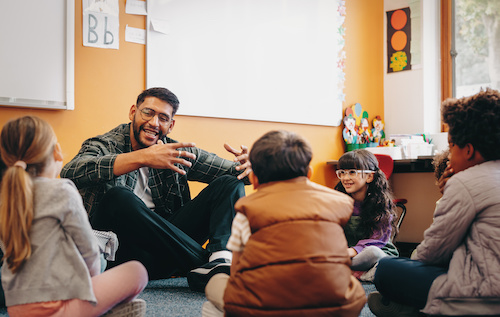Key points:
- SEL teaches students to think and behave like healthy, mature adults
- SEL helps students become better learners and take ownership of that learning
Every educator hopes to equip their students with the knowledge they need to thrive as a healthy adult. It’s a daunting task, especially considering there is so much to teach in such a small amount of time.
We want students to fall in love with reading while building up skills in language and grammar. We try to show them that math and science can be outlets of wonder and imagination, while also grounding them in foundations of history and social studies. And yet, out of all the knowledge at our disposal, fostering healthy social-emotional learning (SEL) may be the most important lesson that we impart to our students.
According to CASEL, the Collaborative for Academic, Social, and Emotional Learning, SEL is “the process through which all young people and adults acquire and apply the knowledge, skills, and attitudes to develop healthy identities, manage emotions and achieve personal and collective goals, feel and show empathy for others, establish and maintain supportive relationships, and make responsible and caring decisions.”
In other words, SEL is about teaching students how to think and behave like healthy, mature adults. This is certainly a worthy goal, but how exactly do we go about teaching this? Well, there is no one-size-fits-all method for teaching SEL, but there are resources that teachers can draw on to start applying these principles in the classroom.
Here are just a few tools for teachers looking to implement social-emotional learning in their classroom:
1. CASEL: As mentioned, CASEL is the Collaborative for Academic, Social, and Emotional Learning. CASEL is helping make evidence-based social and emotional learning an integral part of education from preschool through high school. It offers many free resources for educators that support this work.
2. Peace First: Peace First is an organization dedicated to building future leaders who can solve problems by connecting with others through compassion, standing up for ideals and others with courage, and creating collaborative change. This is a resource worthy of getting to know better. Peace First currently has a focus on supporting young people ages 13-25 to create a more compassionate, just, and peaceful world by providing digital tools, community support, start-up funding and stories that celebrate their social change journeys and impact.
3. Second Step: Second Step is a comprehensive SEL program available for schools to purchase. However, the website’s free resources can also be incredibly helpful. These include a selection of lessons, activities, and materials for early learners, families, and educators.
4. Kindness Curriculum: The Kindness Curriculum is inspired with the mission to make the world a kinder place. The Kindness Factory, Kaplan academics, Kindness ambassadors, and the community have collaborated to create activities that promote kindness attributes to children and students. The free resources available are both practical and engaging, and these offerings are quite extensive. Best of all, they are inquiry-oriented with lots of opportunities to get students thinking.
5. Truth Be Told: Truth Be Told includes activities that help teens truly process key social emotional learning concepts. Great for middle and high school classes, these SEL activities use quotes, along with a variety of learning strategies, to help teens understand social emotional learning topics including healthy decision making, reducing risk, communication skills, positive interpersonal relationships, self-awareness, acceptance and inclusion, responsibility, and more.
Social-emotional learning can seem intimidating at first, but with patience and time, students won’t just become better learners, they’ll become better people. So, take a moment and explore the fundamentals of social-emotional learning. The maturity gained from SEL skills will support students long after they’ve left the classroom, and for an educator, that type of knowledge is priceless.
Related:
Why SEL is the foundation of Future Schools
How did the pandemic impact students’ social capital?
- 4 ways to encourage play in education - April 25, 2024
- CoSN IT Leader Spotlight: Lisa Higgins - April 25, 2024
- It’s time to pay student teachers - April 25, 2024

